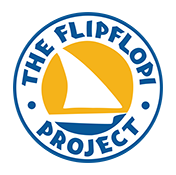Boatbuilding Centre of Excellence
We built the world’s first 100% recycled plastic sailing ‘dhow’ and are now
building different types of boats at our lamu facility
THE WORLD’S FIRST 100% RECYCLED PLASTIC SAILING DHOW - FLIPFLOPI NDOGO
We pioneered our low-tech plastic boatbuilding technique when we created Flipflopi Ndogo: at 9 metres in length and weighing about 7 tonnes, the boat was launched in Lamu in September 2018 by Kenya’s Minister for Tourism and Wildlife, the Lamu County Governor, media, and crowds of local Lamunians, all interested in seeing the spectacle created using waste plastics collected from the shorelines of the Kenyan coast.
Our dhow has sailed 2,500km+ directly engaging over 10,000 people and inspiring millions and was named as one of the top 10 Innovations by the UN in 2019, chosen as the centre-piece exhibit for UNEA-4 boarded by President Kenyatta and UN Deputy Director General Amina Mohammed.
DAU LA MWAO
In 2022, we piloted our heritage boatbuilding course, teaching practical circular economy skills to local students and boatbuilders, using waste plastic as the raw material.
The students final project was to help design and build a local fishing dhow “Dau la Mwao” that was constructed from 700kg of recycled plastic.
Taxi boat
Boats and donkeys are the most commonly used form of transport in Lamu Island but traditional dhows have sadly been superseded by fiberglas boats.
In 2023, we launched Lamu’s first recycled plastic “Taxi” dhow, our third recycled plastic boat prototype now sailing around the archipelago. Powered by a solar engine, it’s being used for transporting goods and leisure trips, we are researching its market potential for commercial viability while using it to stress test new construction and sealing techniques.
flipflopi kubwa: an Ocean-Faring dhow that will embark on a global voyage
In 2023, we began R&D into our second dhow, that will be three times the size of Flipflopi Ndogo, constructed from 100% recycled plastic waste leveraging centuries-old boatbuilding techniques.
When complete, Flipflopi Kubwa will embark on an unprecedented global ocean voyage that we believe will be a catalyst for engagement and action on a global scale.
If you’re interested in partnering with us for this revolutionary mission, get in touch with us here.
BOAT-BUILD TOOLKIT
We made this Boat Building toolkit to walk you through the steps we took to make the Flipflopi Ndogo.
Within this toolkit is all the information you need to start collecting materials, learning processes and how to put it all together.
May these pages serve as a starting point, reference or motivation for anyone interested in turning plastic waste into an awesome BIG idea.
boat-building videos
We’ve built 3 boats and pioneered techniques including plastic welding and heritage carving. This playlist contains a full collection of our boat-building content from our Ndogo repairs to a full guide on building a recycled fishing dhow.
“To create the Flipflopi boat we used only locally available resources and low-tech solutions, enabling our techniques and ideas to be copied without any barriers. So we hope people around the globe are inspired by our beautiful multicoloured boat and find their own ways to repurpose ‘already-used’ plastics”
Research and development
We’ve come a long way since building Flipflopi Ndogo when we were outsourcing our first planks - to now successfully extruding 20ft long planks at our own boatbuilding centre, we are continuously improving our techniques, but know that up-cycled plastic offers a viable sustainable material boatbuilding. Read our latest publications below.
Sustainable Manufacturing & Environmental Pollution
“A new study using evidence from projects including Flipflopi to produce estimations of how many days / years of life are saved by recovering and upcycling waste plastics. Depending on the case and context, up to 24 years of healthy life can be collectively gained for every 1000 tons of plastic material that is recovered and turned into useful materials. The study has also factored in the health and environmental risks that come with recycling.”
Circular Economy Design Inspiration
This paper first presented at the 15th International Marine Design Conference, shows that novel marine design approaches, such as implementing a circular economy approach at a local scale, is effective in responding to global environmental crises such as plastic pollution. Whilst this process can be used for replacing timber in many applications, the iconic design of a traditional sailing dhow is a powerful tool that impacts on community, enterprise and engagement for environmental sustainability.
Routledge Handbook of Archaeology and Plastics
The Flipflopi illustrates the viability of using ocean-bound plastics to develop solutions using traditional and local knowledge – combining heritage preservation and environmental awareness. Combining this success with a community-based waste management system, the Flipflopi Project has established a Recycling and Heritage Boat Building Training Centre to design and construct recycled plastic sailing vessels and other products rooted in heritage based on indigenous knowledge and skills.

















